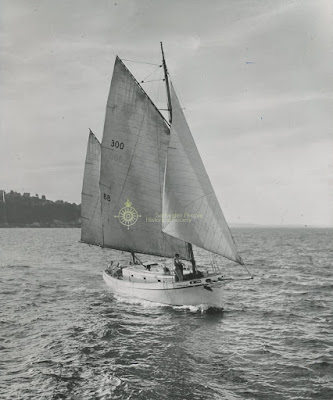If a guest aboard my boat asks where the bathroom is, I tell him or her. I have no bathroom aboard. It is a head. But no matter. Let them call the fantail the back porch and never mind.
Thank heaven I have no vangs aboard. I am not sure what vangs are or is. My handy-dandy mariner's dictionary does not adequately define vangs. I think none is lurking in my gaff-rigged sloop. Or if one is, may it rest undisturbed. My baggywrinkles are fine, thank you.
I have crutches aboard that have nothing to do with physical impairment. They hold up the mainsail boom when the sail is furled. They are two varnished boards hinged like scissors. The boom rests on the X.
Nautical terminology is as complicated and wispy as the English language. We try to describe ships, scantlings and rigging in a hodgepodge borrowing from French, Dutch, Spanish, Latin, Scandinavian and Chaucer-era English that when read aloud by an expert sounds like High German.
It is hopeless.
I have a doghouse aboard but no dog. I herewith avoid mention of cats and houses for obvious reasons. But "cat" does figure prominently in nautical terminology.
I am in deep trouble, subject to censure, by my grumblings over traditional nautical designations. I should be an example-setter as the Times maritime editor and an avid weekend sailor and professed old-ships buff. But there comes a time for bare-faced honesty in the name of common sense.
I am thinking of installing a gallows on my sloop, but nobody will be hanged. A gallows is a permanent support for the main boom.
 |
| John Alden cutter JOHANNA launched Shaw Island, 1987. Sailing the San Juan Islands with her Boom Gallows, designed and crafted by Kit Africa. |
He listened and then looked at me questioningly.
'I'm going to eliminate my cock-pit crutch in favor of a fixed boom prop atop my doghouse,' I said.
How would I have stated it more precisely?
What you really want is a gallows,' he said smugly.
'Which would belay the vangs,' I said matter-of-factly with intent to befuddle. Then I laid my topper on him: 'that way, I won't have to watch for bothersome dollops.'
If you're ever a guest aboard a freighter and wish to impress a master mariner, ask him about the Plimsoll mark on the ship's side. It shows when the maximum load is aboard. Samuel Plimsoll, a Briton, fought valiantly for adoption of the Plimsol mark. He finally won the consensus of an international maritime convention in 1929.
Plimsoll marks are complicated. But simplified, the abbreviations signify drafts, such as FW for fresh water, IS for Indian Ocean summer, S for summer, W for winter and WNA for winter in North Atlantic.
Remember that.
On your first visit to a yacht, don't call ropes ropes. There are only two ropes aboard––the bell rope and the foot rope on old sailing ships. Call the others lines, sheets or halyards. Please don't ask me why. (Except that a halyard once was a 'haul yard.')
Speaking of salts, I'll never know why a three-cornered sail is so hard to identify by its parts.
To my oversimplified way of thinking, there's a foreside, bottom side and slant side. But heaven forbid substitution for luff (fore,) leech (slant) and foot (bottom.) The ropes, hanging from it are the halyards and sheets. And watch out for the lazy jacks. A lanyard is something else, which many an old salt will defend as a bell rope.
Once when writing an article I wearied of the repeated word 'sails.' The subject was about sails, but he word became unbearably excessive. So I deftly inserted 'sheets' as inconspicuously as I could––in the vernacular of 'bed sheets.'
The uproar of reaction in my mailbag was startling. A sheet is a line used for maneuvering sails. On a boat a sheet is a sheet is a sheet.
There are other peculiarities. A john boat is not what the word implies.
A gin pole has nothing to do with a martini, but splicing the main brace does. A gimlet is an anchor turned after it has been rove to the hawspipe. Gins are iron sheaves set in iron shells. A jigger is light tackle for various work about docks or to rig booms in or out.
Port is one side and the starboard the other. Time was, port was known as 'larboard'––often confused in high-wind noise with 'starboard.' So the word was changed.
Legend has it that a master mariner acquired a secret box when the change to 'port occurred. He kept the box locked. He often left the wheelhouse watch stealthily to open the box and furtively peer within. Then he'd slam the lid and click the lock.
Finally he retired in old age––swallowed the anchor––and settled ashore in a snug haven. The box was left aboard and unclaimed. It was forced open by those who remembered the old gent's peculiar manners.
Inside was a scrap of paper with the notation: 'Port means left and starboard means right.'"
Above text verbatim from My Waterfront. Carter, Glen; Seattle, WA. Seagull Books Pub. 1977.





















